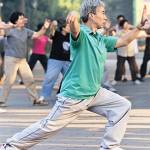(Reuters Health)—People who exercise may lower their odds of developing low back pain or may reduce the intensity of back pain they do experience, a research review suggests.
Compared to people who didn’t exercise, those who did were 33% less likely to develop low back pain, the analysis of data from 16 previously published studies found. Pairing exercise with patient education about back pain was associated with 27% lower odds of developing low back pain, the study also found.
“The study shows that exercises for strengthening and stretching the lumbar and abdominal muscles, or a combination of strengthening and aerobic exercises protect against low back pain,” said lead study author Dr. Rahman Shiri of the Finnish Institute of Occupational Health in Helsinki.
“Furthermore, exercise reduces the severity of low back pain as well as disability due to low back pain,” Shiri said by email.
The researchers analyzed results from previous experiments that randomly assigned people with or without back pain to start different exercise routines. They also looked at some studies that compared exercise alone or exercise paired with education.
Altogether, the studies in the analysis had a total of 4,310 participants. Individual studies ranged in size from 30 to 901 participants and followed people for 2 to 24 months.
Many of the trials included stretching exercises, and some looked at strengthening, aerobic fitness, endurance, balance, coordination and motor skills.
Four studies were conducted in Japan, three in Denmark, two in Sweden and one each in Canada, Finland, Italy, New Zealand, Thailand, the UK and the United States.
Five studies only included people who didn’t have back pain to see if they developed it, while the rest included participants with and without back pain.
Exercise alone, compared to no physical activity, was associated with a 38% lower risk of disability due to low back pain, an analysis of five studies found. Adding patient education to exercise got similar results, one study concluded.
While exercise appeared to also lower the chances that participants would seek medical care or go on sick leave for low back pain, the difference was too small to rule out the possibility that it was due to chance.
One limitation of the review is that it focused on people in the general population, so it’s possible the impact of exercise might be different for individuals already suffering from low back pain, the authors note online October 19 in the American Journal of Epidemiology.


